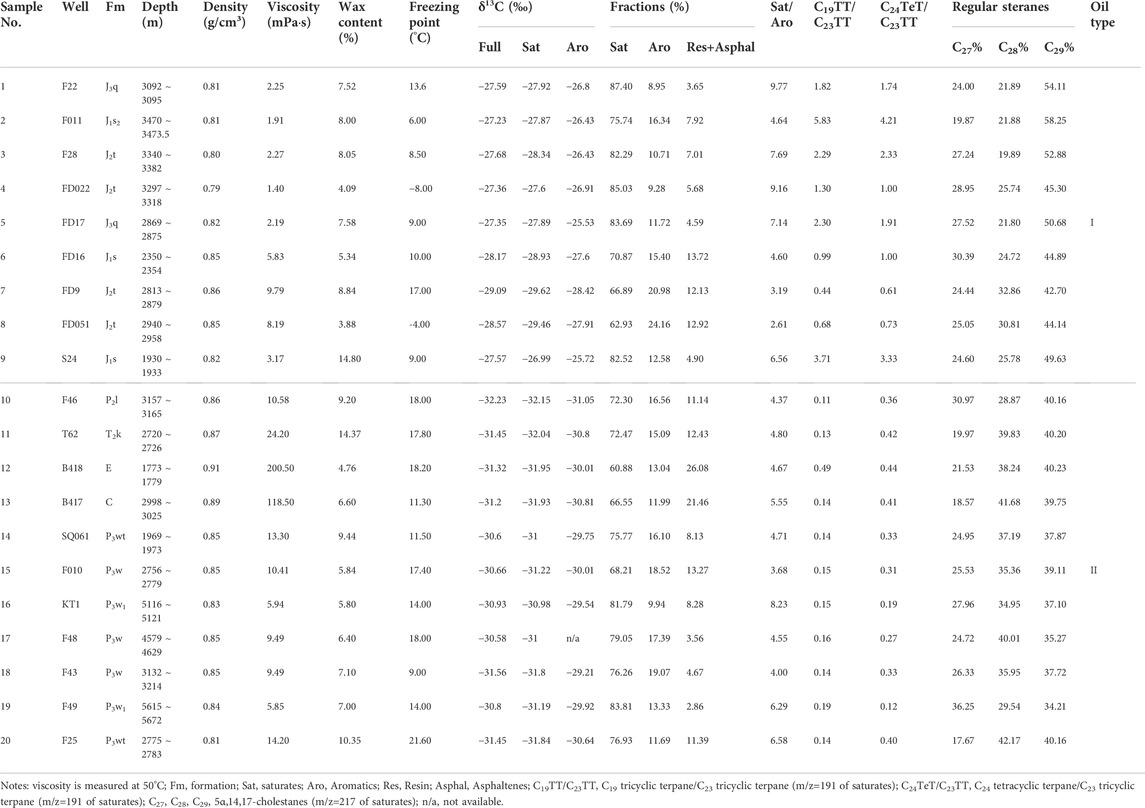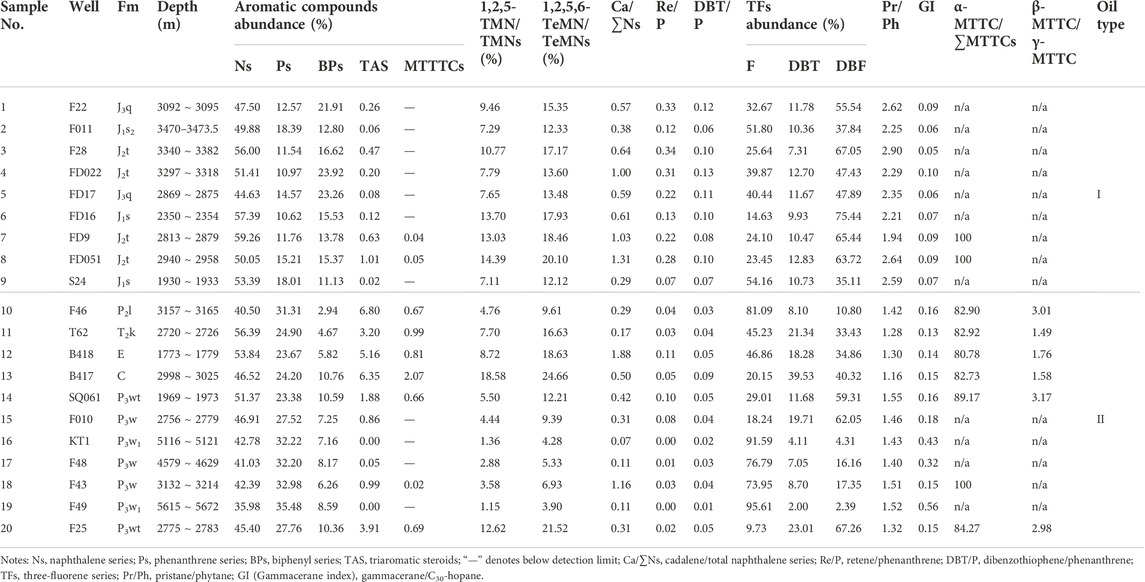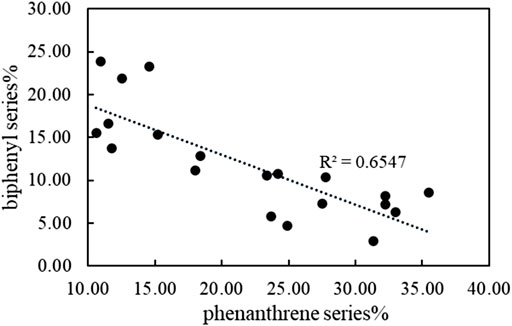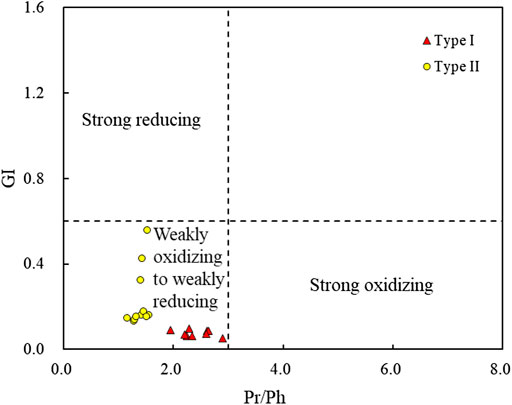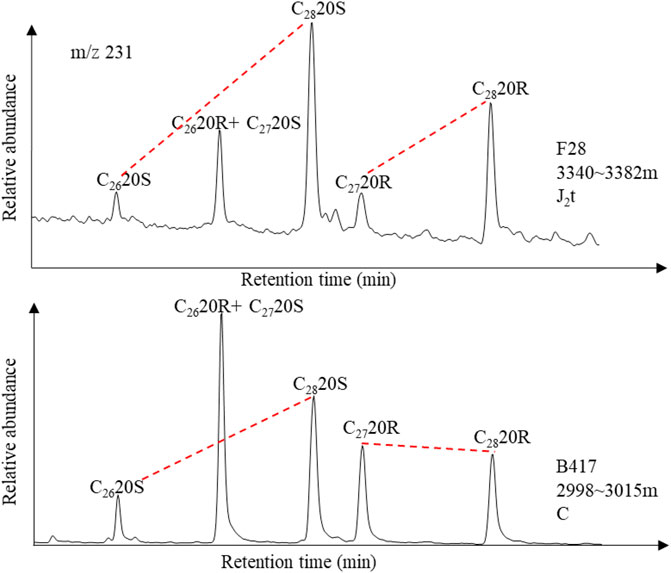- 1School of Energy Resources, China University of Geosciences, Beijing, China
- 2Key Laboratory of Marine Reservoir Evolution and Hydrocarbon Accumulation Mechanism, Ministry of Education, China University of Geosciences, Beijing, China
The aromatic compounds of twenty crude oil samples from different formations in the East Fukang Sag were studied by the gas chromatography–mass spectrometry technique. Through analysis of the composition of the main aromatic hydrocarbons, the studied crude oil samples were generally divided into two types: Oil type I had the relatively high content of the naphthalene series, biphenyl series and dibenzofuran series, while the samples from Oil type II contained relatively high abundance of phenanthrene series, fluorene series, triaromatic steroid series, and obvious methyltrimethyltridecylchromans. The geochemical parameters reflecting the source and sedimentary environment in naphthalene series, phenanthrene series, biphenyl series, three-fluorene series, and triaromatic steroid series were systematically analyzed. Analysis of the results showed that studied oil samples from the East Fukang Sag were of continental origin and deposited in a weakly oxidizing to weakly reducing environment with fresh-brackish water. Oil type I was characterized by considerably abundant terrestrial higher plant organic matter inputs, while Oil type II was typical with obviously lower aquatic organisms. Maturity-related parameters calculated from alkyl naphthalenes, alkyl phenanthrenes, alkyl dibenzothiophenes, and methyltrimethyltridecylchromans showed that all the studied oil samples have reached the mature stage.
1 Introduction
The source of organic matter, depositional environment, and maturity of crude oil are of great significance for oil and gas exploration. They can be used to identify the possible source rocks and maturation stage of oil expulsion, and understand the rules of oil and gas accumulation in the region (Guo and He, 2009). As important components ubiquitous in crude oil and source rocks, the aromatic hydrocarbons, have drawn more and more attention in recent years. Compared with saturated hydrocarbons, aromatic hydrocarbons are more resistant to biodegradation, which can also provide significant information on the origin of organic matter (Püttmann and Villar, 1987; Alexander et al., 1988; Radke et al., 1994), depositional environment (Fan et al., 1990; Li and He, 2008), thermal maturity (Radke et al., 1982, 1986; Radke and Willsch, 1994), oil-source correlation (Alexander et al., 1992), and oil migration (Li et al., 2011; Fang et al., 2016). Moreover, the maturity parameters based on aromatic hydrocarbons have a wider indication range than the sterane and hopane isomerization parameters of saturated hydrocarbons in evaluating the degree of thermal evolution. Therefore, it is a useful supplement to the study of saturated hydrocarbons (Peters and Moldowan, 1993; Peters et al., 2005).
The Fukang Sag is the largest hydrocarbon-generating sag within the Junggar basin, and is one of the main oil and gas source kitchens in the eastern, southern, and hinterland of the Junggar Basin (Zhang et al., 2020). The study area has experienced polycyclic tectonic-sedimentary evolution, forming multiple sets of favorable source-reservoir-seal assemblages (Wang et al., 2018). Hence, the crude oil in the East Fukang Sag shows various properties and complex oil-source relations (Chen et al., 2016; Liu et al., 2020). Previous studies in this area have primarily focused on the tectonic evolution and depositional characteristics (Wu, et al., 2013; Ma C. et al., 2019; Luo et al., 2019), reservoir characteristics (Cao et al., 2017; Wang et al., 2018; Ma S. et al., 2019), hydrocarbon accumulation characteristics (Wu et al., 2013; Shi, 2017), geochemical characteristics of source rocks (Fu et al., 2011; Bai et al., 2017; Shi et al., 2018; Yang et al., 2019; Qiao et al., 2020; Zhang et al., 2020) and geochemical characteristics of saturated hydrocarbons in crude oil (Yang et al., 2012; Pan et al., 2015; Wang et al., 2016; Liu et al., 2020; Song et al., 2020; Chen et al., 2022). However, rare reports described in detail the geochemical characteristics of aromatic hydrocarbons in crude oil from the East Fukang Sag (Yang et al., 2005; Liu, et al., 2020). Therefore, in this paper, twenty crude oil samples from the East Fukang Sag were investigated by gas chromatography (GC) and gas chromatography–mass spectrometry (GC–MS) techniques. We systematically analyzed the geochemical characteristics of aromatic hydrocarbons, discussed the biological source and depositional setting of organic matter, and determined the oil maturity, which can be an important supplement for the study of the geochemical characteristics of crude oil in this area. It is expected to provide some geochemical basis for the genesis of hydrocarbons and identification of oil sources in this area.
2 Geological setting
The Junggar Basin is located in the northern part of Xinjiang Uygur Autonomous Region, NW China. It is shaped like a subtriangle narrow in the north and wide in the south and surrounded by mountains ranges from the western, northeastern, and southern sides, which covers an area of about 130,000 km2 (Cao et al., 2017; Figure 1A). It is a large superimposed basin which is underlain by part of Hercynian folded basement and Precambrian crystalline basement (Wu et al., 2005; Qiao et al., 2020). The basin has experienced Hercynian, Indosinian, Yanshanian, and Himalayan tectonic movements, which can tectonically be divided into three evolutionary stages: the rift basin stage, depression basin stage, and foreland basin stage (Wan et al., 2015; He et al., 2018; Figure 2). The Fukang sag lies in the east of Junggar Basin which belongs to the Central depression. The study area is located in the eastern part of Fukang Sag (Figure 1B).
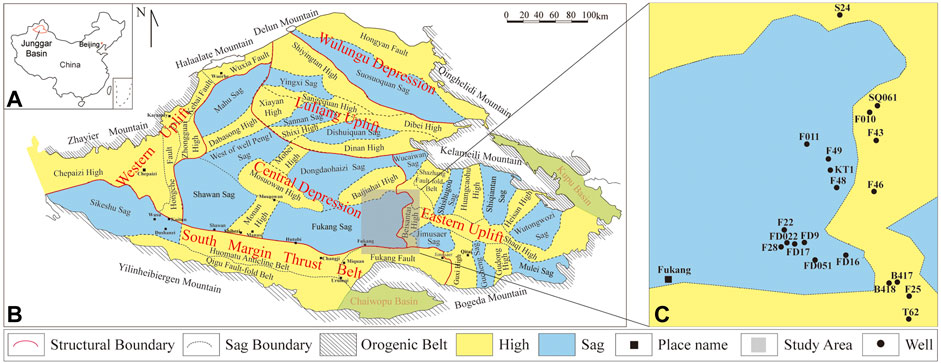
FIGURE 1. (A) The location of the Junggar Basin in China, (B) its structure outline map and (C) the study area.
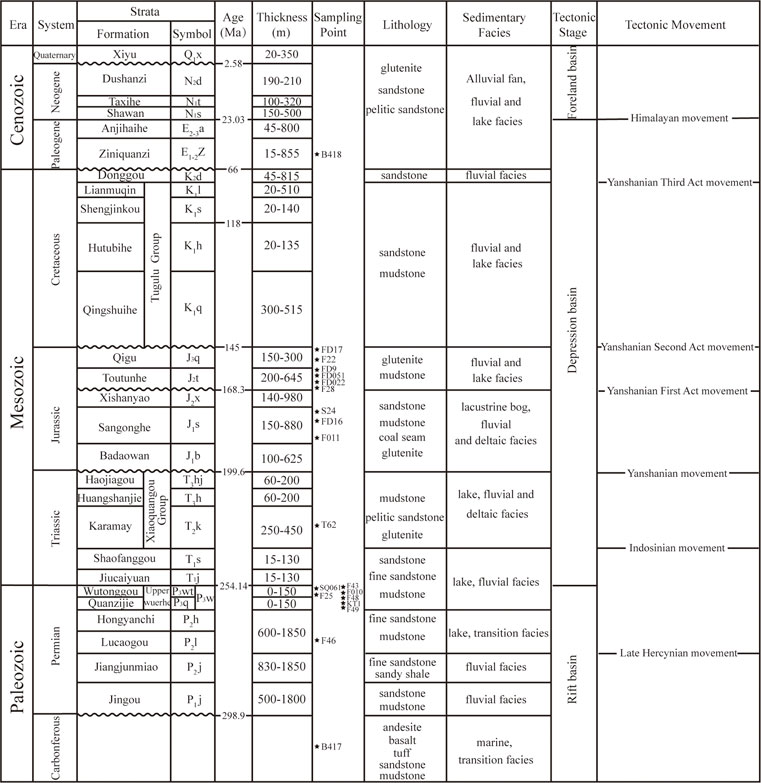
FIGURE 2. Generalized stratigraphic column of the eastern Junggar Basin (modified from Cao et al., 2017; Bai, et al., 2017; He et al., 2018).
The sedimentary strata in the study area are completely developed, including Carboniferous to Quaternary sediments with a total thickness of 10 km (Qiao et al., 2020; Figure 2). The Carboniferous strata developed typical marine sediments and pyroclastic sediments. The Permian mainly consisted of fluvial and lake deposits. The middle Permian Lucaogou Formation (P2l), deposited in fresh-brackish deep to semi-deep lakes, is the most important source rock in the study area. The sedimentary range of Triassic was larger than that of Permian. The middle and upper Triassic were mainly fluvial, lake, and deltaic deposits, containing amounts of glutenite. The Jurassic strata were mainly deposited in a shallow lake and swamp environment with the source rocks being mainly dark mudstone, carbon mudstone, and coal seams. The Cretaceous mainly belonged to fluvial deposits where sandstones were abundant. The Cenozoic strata were dominated by alluvial fan and fluvial clastic deposits (Chen et al., 2016; Bai, et al., 2017; Cao et al., 2017). Thereinto, four sets of source rocks (i.e., Carboniferous, Permian, Triassic, and Jurassic) and multiple oil-bearing series (i.e., Carboniferous, Permian, Triassic, Jurassic, Cretaceous, Paleogene, and Neogene) were developed (Chen et al., 2016).
3 Samples and methods
3.1 Samples
In this study, twenty crude oil samples from different depths and reservoirs in East Fukang Sag were obtained for geochemistry analysis. The well locations of these samples were shown in Figure 1C, and the basic characteristics of the samples were presented in Table 1.
3.2 Methods
The studied oil samples were performed to precipitate with an excess of n-hexane, then the n-hexane soluble portion of samples was further separated by column chromatography into saturated, aromatic and resin fractions using silica gel/alumina (2:1, v/v) columns by gravimetric analysis. The saturated fraction was eluted with n-hexane, the aromatic fraction was eluted with dichloromethane/n-hexane (2:1, v/v) and the resin fraction was eluted with dichloromethane/methanol (93:7, v/v). The collected saturated and aromatic fractions evaporated the solvent at room temperature and then transferred into 2 ml sample vials for GC and GC–MS analysis.
GC analysis of the pristane and phytane in the saturated fractions were conducted on an Agilent 7890A gas chromatograph fitted with an HP-5MS fused silica capillary column (60 m × 0.32 mm × 0.25 μm film thickness). Nitrogen was the carrier gas. The oven temperature was programmed to start at 40°C for 2 min, increasing to 310°C at 4°C/min, and then holding for 20 min. Data were acquired using an Agilent ChemStation.
GC–MS analysis of the saturated and aromatic fractions were performed on an Agilent 7890A-5975C GC–MS system equipped with an HP-5MS fused silica capillary column (60 m × 0.25 mm × 0.25 μm film thickness). The GC operating conditions were as follows: the initial temperature was held at 40°C for 2 min, heating to 300°C at a rate of 4°C/min, and then holding for 30 min. Helium was used as the carrier gas. The injector temperature was set to 300°C. The MS was operated at 70 eV in the EI (electron ionization) mode over a scan range from m/z 50 to 600. Compounds were identified by searching the NIST library and comparing with published mass spectra, as well as the retention indices from literature data. Ratios used in this study were calculated by measuring the peak areas in the appropriate molecular ion chromatograms.
The stable carbon isotope analysis of crude oil and its components were completed by the CNPC Xinjiang Oilfield Company. They were performed on a Thermo Fisher MAT-253 instrument coupled to a Flash EA 1112. The whole oil and its saturated and aromatic fractions were burned into CO2 in the EA combustion furnace (about 980°C). The stable carbon isotope values were calibrated relative to the Vienna Pee Dee Belemnite (VPDB) standard. Every sample was measured at least twice consecutively until the error was less than 0.1‰.
4 Results and discussion
4.1 Basic geochemical characteristics of crude oil
In this study, most crude oil samples were light oil with low viscosity, especially crude oil from Jurassic (Table 2). Except for Samples 12 and 13, the density of studied crude oil was between 0.79 and 0.87 g/cm3 (average 0.83 g/cm3) and the viscosity at 50°C ranged from 1.4 mPa·s to 24.2 mPa·s (average 7.70 mPa·s). The wax content of studied crude oil varied in the range of 3.88%–14.80% (average 7.82%), which belonged to medium-high wax crude oil. The freezing point was relatively low, ranging from −8.00°C to 21.60°C, with an average of 11.26°C. The group composition of crude oil samples was predominately saturated hydrocarbon, ranging from 60.88% to 87.40% (average 75.57%). The aromatic hydrocarbon accounted for 8.95%–24.16% (average 14.04%). The ratios of saturated/aromatic hydrocarbon ranged from 2.61 to 9.77 (average 5.64), suggesting that the maturity of crude oil samples was relatively high (Cheng et al., 2020).
The distribution of n-alkanes in all crude oil samples was complete, typically varying from nC10 to nC31, which indicated that crude oil was not biodegraded basically. Hence, these crude oil samples can represent the original geochemical information of crude oil generation. The C27-C28-C29 regular steranes and tricyclic terpanes in crude oil showed different distribution characteristics, indicating that the organic matter input of crude oil in East Fukang Sag had both lower aquatic organisms and terrestrial higher plants (Philp and Gilbert, 1986; Figure 3).
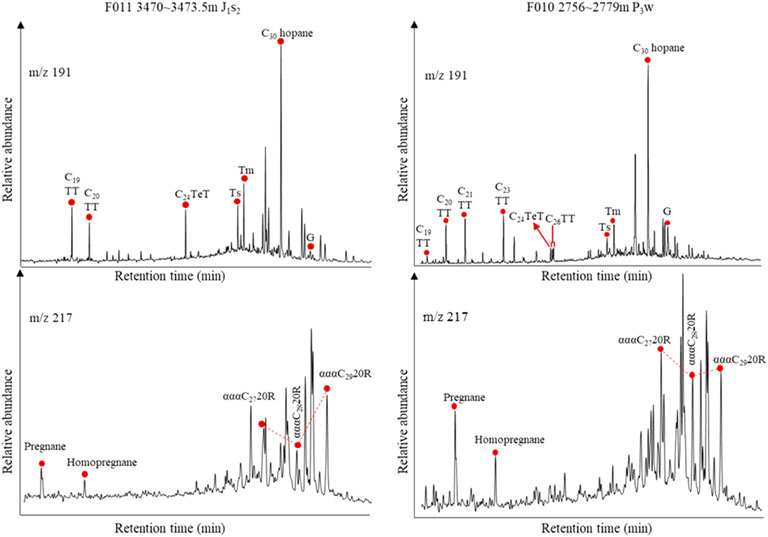
FIGURE 3. Typical biomarker chromatograms of saturated hydrocarbons in crude oil in the East Fukang Sag. m/z 191= terpanes, m/z 217=steranes, Ts=C27-18α(H) trisnorhopane, Tm=C27-17α(H) trisnorhopane, G=gammacerane.
4.2 Composition characteristics of aromatic hydrocarbons
Generally, there are three peaks on the TIC of aromatic compounds in crude oil: naphthalene and alkylnaphthalenes (dicyclic compounds), phenanthrene and alkylphenanthrenes (tricyclic compounds), other polycyclic aromatic hydrocarbons plus aromatic steroids and terpenoids. The aromatic hydrocarbons in immature-low mature oils are dominated by tetracyclic and pentacyclic compounds and the TICs show back or bimodal peaks, while chromatograms of aromatic hydrocarbons from crude oil with moderate to high maturity show the front peaks of dicyclic and tricyclic compounds in predominance. In this study, a total of 14 series of more than 170 aromatic compounds were detected in the samples, mainly including naphthalene series, phenanthrene series, biphenyl series, three-fluorene series (dibenzofuran series, dibenzothiophene series, and fluorene series), fluoranthene series, pyrene series, chrysene series, triaromatic steroid series, benzofluoranthene, benzopyrene series, benzofluorene series and methyltrimethyltridecylchromans (MTTCs) (Figure 4). The relative contents of all the compounds were calculated by normalizing the peak areas, and the results showed that the TICs of aromatic hydrocarbons in the studied crude oil exhibited a front peak distribution of bicyclic and tricyclic compounds (accounting for over 80%), which indicated relatively high maturity of the crude oil samples (Figure 5). According to the relative contents of main aromatic compounds, the studied crude oil could be divided into two types: Oil type I showed the highest content of naphthalene series (44.6%–59.2%, with an average of 52.17%), followed by the relative content of biphenyl series (11.13%–23.92%, with an average of 17.15%) and phenanthrene series (10.62%–18.39%, with an average of 13.74%). The relative abundance of other aromatic hydrocarbon series decreased in the order of three-fluorene series (the content of dibenzofuran series was the highest), chrysene series, fluoranthene series, triaromatic steroid series, benzofluorene series, while the contents of the remaining four aromatic hydrocarbon series were very low. In comparison, Oil type II was dominated by naphthalene series (35.98%–56.38%, with an average of 45.73%) and phenanthrene series (23.38%–35.48%, with an average of 28.69%), while the biphenyl series was in a rather low amount (2.94%–10.76%, with an average of 7.51%), then followed by the content of three-fluorene series (the content of fluorene series was the highest), triaromatic steroid series, chrysene series, pyrene series and MTTCs. The contents of the remaining four aromatic hydrocarbon series were very low (Figures 4, 5).

FIGURE 4. The composition characteristics of aromatic hydrocarbons in crude oil from the East Fukang Sag. Notes: 1) Naphthalene series, 2) Phenanthrene series, 3) Biphenyl series, 4) Fluorene series, 5) Dibenzothiophene series, 6) Dibenzofuran series, 7) Triaromatic steroid series, 8) Fluoranthene series, 9) Pyrene series, 10) Chrysene series, 11) Benzofluoranthene, 12) Benzopyrene series, 13) Benzofluorene series, 14) MTTCs.
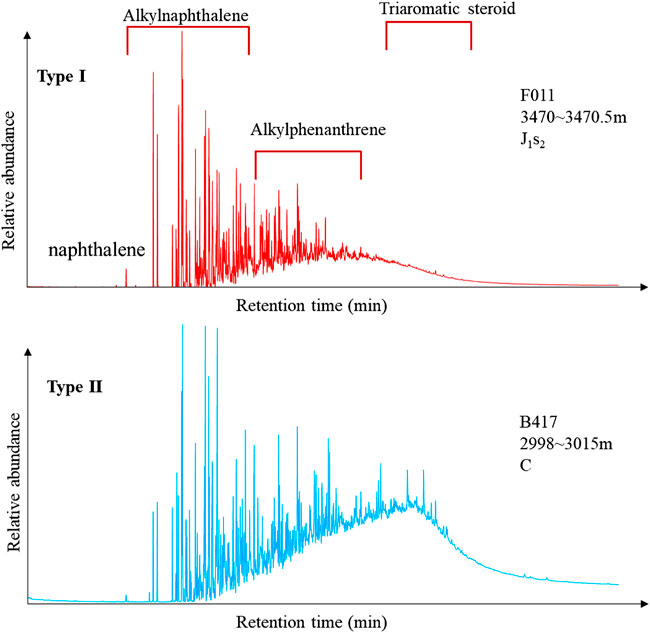
FIGURE 5. Total ion chromatograms (TIC) of aromatic fractions in crude oil from the East Fukang Sag.
4.3 Sources of organic matter
4.3.1 Carbon isotope composition of aromatic hydrocarbons
The carbon isotopes of whole oil and its fractions are inherited from those of sedimentary organic matter, and generally, the difference of stable carbon isotope values (δ13C) of crude oil from the same source due to different maturity is no more than 2‰–3‰ (Schoell, 1984; Peters and Moldowan, 1993). Therefore, the carbon isotope characteristics can be a good indicator of oil-oil and oil-source correlation. The δ13Caro values of Oil type I ranged from −25.53‰ to −28.42‰, while that of Oil type II were light with δ13Caro from -29.21‰ to -31.05‰ (Figure 6), indicating that the two types of crude oil were generated from different source rocks and the Oil type II had obvious lower aquatic organisms organic matter input (Li et al., 2003). In addition, Oil type I showed a strong dominance of the C29 sterane, ranging from 42.70% to 54.11% (average 49.18%), Oil type II were relatively more enriched in C28 and C29 steranes, with relative abundance of 28.87%–42.17% (average 36.71%) and 34.21%–40.23% (average 38.34%), respectively (Table 2). Meanwhile, the values of C19TT/C23TT and C24TeT/C23TT of Oil type I (ranging from 0.44 to 5.83 and 0.61–4.21, respectively) were much higher than those of Oil type II (ranging from 0.11 to 0.49 and 0.12–0.44, respectively). The characteristics of these biomarkers also reflected that the organic matter input of Oil type I was mainly terrestrial higher plants and Oil type II was mainly lower aquatic organisms (Peters et al., 2005; Gong et al., 2019).
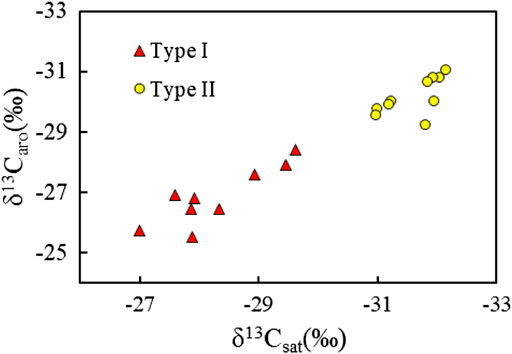
FIGURE 6. The plot of carbon isotope between saturated hydrocarbons and aromatic hydrocarbons of studied oil samples in the East Fukang Sag.
4.3.2 Naphthalene and its alkyl derivatives
The naphthalene series in the samples included naphthalene (N; m/z 128), methylnaphthalenes (MNs; m/z 142), ethylnaphthalenes (EtNs; m/z 156), dimethylnaphthalenes (DMNs; m/z 156), trimethylnaphthalenes (TMNs; m/z 170), tetramethylnaphthalenes (TeMNs; m/z 184) and pentamethylnaphthalenes (PMNs; m/z 198). They were characterized by predominant DMNs and TMNs (accounting for more than 60% of total naphthalenes), followed by the content of MNs, N, EtNs and PMNs. Relative distribution of naphthalene series is related to the nature of source and depositional environment (Strachan et al., 1988; Radke et al., 1994), but the current understanding of the biogenesis of naphthalene series is not clear enough (Armstroff et al., 2006). Tuo, 1996 believed that naphthalene series may be closely related to terrestrial higher plant sources. It is commonly accepted that 1,2,5-TMN and 1,2,5,6-TeMN can be useful indicators of the input of higher plants in crude oil (Püttmann and Villar, 1987; Alexander et al., 1988; Strachan et al., 1988). 1,2,5-TMN/TMNs ratio of studied oil samples varied from 1.14% to 18.58%, and the average values of Oil type I and Oil type II were 10.13% and 6.48%, respectively. In addition, 1,2,5,6-TeMN accounted for 3.89%–24.66% of TeMNs, the average values of Oil type I and Oil type II were 15.62% and 12.10%, respectively. Based on the study by Zhu (1996), it potentially indicated that the studied crude oil was of continental origin. Besides that, cadalene (1,6-dimethyl-4-isopropylnaphthalene) is thought to originate from compounds with the cadalene carbon skeleton, which are especially abundant in plant resins and essential oils derived from land plants (Singh et al., 1994). The content of cadalene in studied crude oil accounted for 0.07%–1.88% of total naphthalene series (Table 2). The abundance of cadalene in Oil type I was higher (average 0.77%) than that (average 0.48%) of Oil type II. Therefore, it indicated that the original organic matter of crude oil in the study area had a certain amount of terrestrial higher plant input, and the input of Oil type I was more than that of Oil type II.
4.3.3 Phenanthrene and its alkyl derivatives
The phenanthrene series detected in the samples contained phenanthrene (P; m/z 178), methylphenanthrenes (MPs; m/z 192), dimethylphenanthrenes (DMPs; m/z 206), trimethylphenanthrenes (TMPs; m/z 220), tetramethylphenanthrenes (TeMPs; m/z 234) and trace ethylphenanthrenes (EtPs; m/z 206). They were characterized by predominant DMPs (25.07%–32.43%, with an average of 29.22%) and MPs (23.14%–32.51%, with an average of 27.73%), the content of TMPs was slightly lower (18.00%–28.58%, with an average of 21.58%), while P, TeMPs, and EtPs were in a rather low amount. Similar to naphthalene series, phenanthrene series are also related to the effects of source and depositional environment (Budzinski et al., 1995; Armstroff et al., 2006). However, unlike naphthalene series which may be derived from terrestrial higher plants, phenanthrene series are closely related to lower aquatic organisms (Tuo, 1996; Xu et al., 2019), and there was an obvious negative correlation between the relative content of phenanthrene series and biphenyl series in the studied oil samples (Figure 7). The abundance of phenanthrene series of Oil type II varied from 23.38% to 35.48% (average 28.69%), which was much higher than that of Oil type I whose content ranged from 10.62% to 18.39% (average 13.74%). This might indicate that the organic matter of Oil type II had more abundant lower aquatic organism input. Moreover, retene (1-methyl-7-isopropylphenanthrene, Re) is probably derived from conifer resins, which is usually used to indicate terrestrial higher plant input (van Aarssen et al., 2000). The Re/P ratio of Oil type I ranged from 0.07 to 0.33 (average 0.22), and that of Oil type II was between 0 and 0.11 (average 0.04, Table 2). It showed that the terrestrial higher plant input of Oil type I was much higher than that of Oil type II.
4.3.4 Biphenyl and its alkyl derivatives
The biphenyl series detected in the studied oil samples included biphenyl (BP; m/z 154), methylbiphenyls (MBPs; m/z 168), ethylbiphenyls (EBPs; m/z 182), dimethylbiphenyls (DMBPs; m/z 182) and trimethylbiphenyls (TBPs; m/z 196). The relative abundance of these compounds in Oil type I decreased in the order of DMBPs > MBPs > TMBPs > BPs > EBPs, while Oil type II showed the distribution of MBPs > DMBPs > BPs > TMBPs > EBPs. Generally, biphenyl series are interpreted to be derived from the lignin of higher plants (Alexander et al., 1986; Cumbers et al., 1987; Tuo, 1996). The relative amount of biphenyl series in Oil type I (13.78%–23.92% of total aromatic hydrocarbons, with an average of 18.53%) was much higher than that of Oil type II (2.73%–10.76% of total aromatic hydrocarbons, with an average of 6.58%), which indicated that the source of Oil type I was richer in terrestrial higher plant organic matter than that of Oil type II.
4.4 Sedimentary environment
4.4.1 Fluorene, dibenzofuran, benzothiophene and their alkyl derivatives
Fluorene (F; m/z 166), dibenzofuran (DBF; m/z 168), dibenzothiophene (DBT; m/z 184) and their alkyl derivatives are deeply studied compounds in aromatic hydrocarbons, they are usually used to indicate the depositional environment, thermal maturity of crude oil and source rocks, and oil migration. Normally, dibenzothiophenes are enriched in strong reducing environments of marine and salt-lake facies, the content of fluorenes is abundant in normal reduction environments, and the content of dibenzofurans is in predominance in an oxidizing environment of swamps and coal measures (Fan et al., 1990; Huang et al., 2006). However, relative contents among DBT, F, and DBF cannot differentiate transitional facies well, and the correlation between ∑OF/∑(OF+F) and ∑SF/∑(SF+F) is believed to be the solution (Li and He, 2008). Consequently, it can be concluded from Figure 8 that the studied crude oil was deposited in a weakly oxidizing to weakly reducing environment (Figure 8A), whereas the depositional environment of Oil type I was more oxidized compared to Oil type II (Figure 8B). It had the same effect as distinguishing the depositional environment by using GI and Pr/Ph (Li and He, 2008; Figure 9).
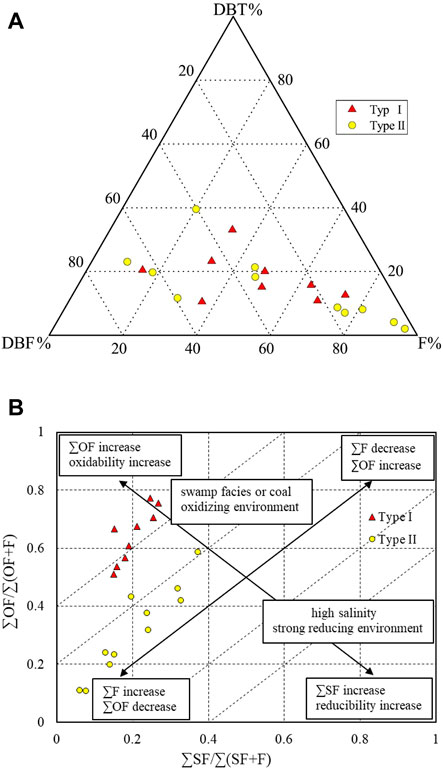
FIGURE 8. (A) Ternary diagram of DBT, F, and DBF of crude oil from the East Fukang Sag, (B) The correlation between ∑OF/∑(OF+F) and ∑SF/∑(SF+F) of crude oil. ∑F, ∑OF and ∑SF refer to the contents of C0-C2 fluorenes, dibenzofurans, and dibenzothiophenes respectively.
Hughes et al. (1995) proposed that the dibenzothiophene/phenanthrene (DBT/P) ratio could be used to classify crude oil source rock depositional environments. Crude oil derived from strong reducing environments, especially source rock lithology with marine carbonates, show the ratios of DBT/p > 1, while in lacustrine depositional environments having ratios of DBT/P < 1. The ratios of DBT/P in studied crude oil from the Fukang Sag were far less than 1, within the range of 0.01–0.13 (Table 2), reflecting the original source of studied crude oil formed in lacustrine depositional environments.
4.4.2 Triaromatic steroids
Triaromatic steroids (TAS) may originated by aromatization and demethylaiton from monoaromatic steroids. Since monoaromatic steroids could be derived from sterols through steranes during diagenesis, triaromatic steroids and steranes potentially share the same precursors (Peters et al., 2005; Li et al., 2012; Li et al., 2015). Triaromatic steroid series in the studied oil samples included triaromatic steroids (m/z 231) and methyl triaromatic steroids (m/z 245). The relative content of TAS of Oil type I ranged from 0.02% to 1.01% (average 0.32%), while that of Oil type II varied from 0% to 6.80% (average 2.65%). In general, the abundance of TAS decreases with the increase of maturity (Jia et al., 2009; Bao et al., 2020). Consequently, the Samples 16 and 19 in Oil type II cannot detect TAS may be linked to their relatively high maturity (Table 3). Crude oil and source rocks deposited in freshwater environments have been reported to have high concentration of C28-TAS, while in saline and brackish water environments it is abundant with C26-TAS (Peters et al., 2005). Ratios of C2620S-TAS/C2820S-TAS of Oil type I were within the range of 0–0.11, showing the characteristics of coal-bearing sedimentary environment of fresh water, the same ratios of Oil type II were within the range of 0.13–0.32, indicating lacustrine environment of fresh-brackish water (Meng et al., 2011, Figure 10). In addition, the cross plot of C2720R-TAS/C2820R-TAS versus C2620S-TAS/C2820S-TAS can be used for oil family classification and oil-source correlation (Peters et al., 2005; Zhu et al., 2009). As shown in Figure 11, it can be seen that two types of crude oil were well divided and the organic matter type of Oil type II was better than Oil type I, probably showing a higher proportion of bacteria and algae input (Li et al., 2015).
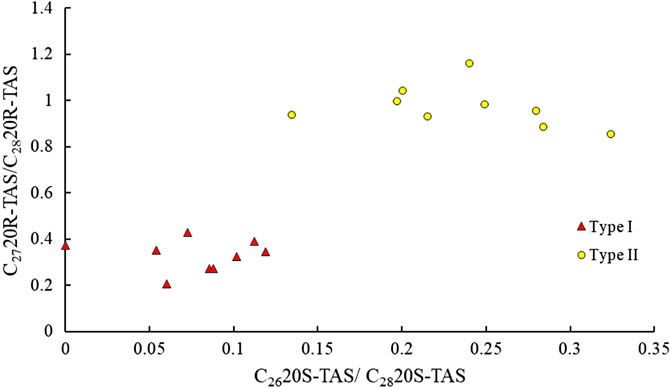
FIGURE 11. The cross plot of C2620S-TAS/C2820S-TAS versus C2720R-TAS/C2820R-TAS in crude oil from the East Fukang Sag.
4.5 Thermal maturity evaluation
The well-established maturity indicators in saturated hydrocarbons, the sterane and hopane isomerization ratios, have been used in many studies to evaluate the maturity of crude oil and source rocks in this area, and good results have been obtained (Yang et al., 2005; Fu et al., 2011; Bai et al., 2017; Gong, et al., 2019). Therefore, they were used as the basis for comparative study in this study. C3122S/(22S+22R) ratio in 17α (H)-extended hopanes was found to be within the range of equilibrium value (0.57–0.62) in most examined crude oil samples (Table 3), implying the maturity of their source rocks was presumed to correspond to Ro > 0.6% (Waples and Machihara, 1990). The ratios of C2920S/(20S + 20R) and C29αββ/(ααα+αββ) sterane for the oil samples were in the range of 0.4–0.48 and 0.36 to 0.56, respectively (Figure 12), both of them were below the equilibrium values, supporting that the oil samples reached the mature stage (Justwan et al., 2006; Stojanović et al., 2007a), and the maturity degree of Oil type II had a wider range than that of Oil type I.
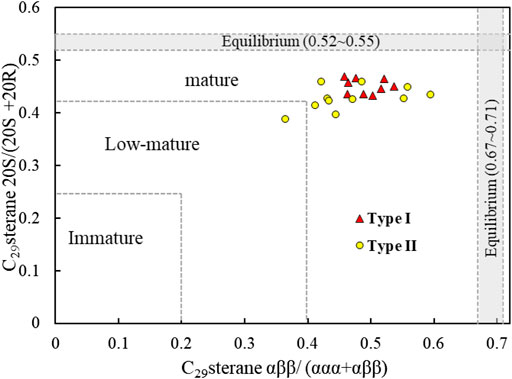
FIGURE 12. Cross plot of C29 sterane αββ/(ααα+βββ) and C29 sterane 20S/(20S+20R) maturity ratios of crude oil in the East Fukang Sag (after Justwan et al., 2006).
4.5.1 Alkyl naphthalenes
With alkylnaphthalenes and alkylphenanthrenes, the isomers which are substituted in β-positions are thermodynamically more stable than substituents in α-positions. Consequently, the abundance of the α-substituted isomers decreases, relative to those of the β-substituted isomers, with increasing maturity (Stojanović et al., 2007b). Based on this notion, many maturity parameters are defined between these isomers, including methylnaphthalene ratio (MNR), dimethylnaphthalene ratio (DNR), trimethylnaphthalene ratios (TNR-1 and TNR-2), and tetramethylnaphthalene ratio (TeMNr) (Table 3). They generally increase with increasing maturity. In this study, they showed a good linear correlation with each other, suggesting that maturity parameters from alkylnaphthalenes can effectively indicate the maturity of studied crude oil. Thereinto, according to the empirical formula for calculating equivalent vitrinite reflectance (Rc1) from TNR-2 proposed by Radke et al. (1986), the Rc1 of studied crude oil was 0.72%–0.98% (average 0.84%), and it indicated studied oil samples were in the mature stage.
4.5.2 Alkyl phenanthrenes
Alkylphenanthrenes are not very susceptible to biodegradation and thus are good maturity indicators of oils over a wide range (Volkman et al., 1984; Radke, 1988). Phenanthrene- and methylphenanthrene-related parameters have long been used for maturity evaluation. MPs include α-substituents 9-MP, 1-MP and β-substituents 3-MP, 2-MP. 3-MP and 2-MP are thermally more stable than 9-MP and 1-MP, which can be originated from the 1-MP and 9-MP by rearrangement and/or from phenanthrene through methylation reactions (Radke et al., 1982). Accordingly, parameters MPR, MPI-1, MPI-2, F1, and F2 were proposed to indicate oil maturity (Table 3). On the basis of the empirical formula from MPI-1 proposed by Radke et al. (1982), the calculated vitrinite reflectance (Rc2) values of crude oil samples ranged from 0.66% to 1.03%, with an average of 0.83%. Additionally, the calculated vitrinite reflectance (Rc3) from F1 (Kvalheim et al., 1987), ranging from 0.60% to 1.21% (average 0.88%), was in reasonably good agreement with MPI-1 measurements. As a consequence, the studied oil samples in the East Fukang Sag were generally in the mature stage, which was consistent with the results obtained from alkyl naphthalene parameters.
4.5.3 Alkyl dibenzothiophenes
Alkyl dibenzothiophenes are resistant to biodegradation and have sustained sensitivity to thermal evolution, making them effective maturity parameters of crude oil from low mature stage to high mature stage. With the increase of thermal evolution degree, methyl dibenzothiophene (MDBT, m/z 198) undergoes methyl rearrangement and demethylation. The methyl rearrangement is mainly represented by the transformation from 1-MDBT and (2+3)-MDBT to 4-MDBT, demethylation is manifested as the transformation from MDBT to DBT. Thus, two parameters, MDR and MDBI (Table 3), were proposed (Radke and Willsch, 1994; Chakhmakhchev et al., 1997; Wei et al., 2001). In addition, Chakhmakhchev et al. (1997) found that with the increase of thermal evolution level, the relative contents of 2,4-dimethyldibenzothiophene (2,4-DMDBT) and 4,6-dimethyldibenzothiophene (4,6-DMDBT) increased, while the relative content of 1,4-dimethyldibenzothiophene (1,4-DMDBT) decreased. Hence, the values of DMDR-1 (4, 6-DMDBT/1, 4-DMDBT) and DMDR-2 (2,4-DMDBT/1,4-DMDBT) increase with the increase of maturity, which can also indicate the maturity of crude oil and sedimentary organic matter. The ratios DMDR-1 and DMDR-2 showed a good positive correlation with MDR and each other (Figure 13), and the calculated vitrinite reflectance from DMDR-1 (Rc4) ranged from 0.75% to 1.50%, with an average of 0.92% (Luo et al., 2001). Although it was a bit higher than Rc1, Rc2 and Rc3 calculated by alkyl naphthalene and alkyl phenanthrene parameters, it could qualitatively reflect that the studied crude oil in the East Fukang Sag was mature oil.
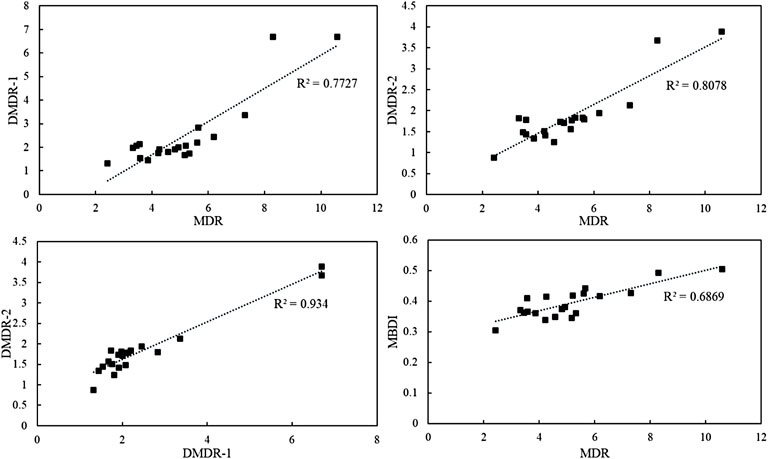
FIGURE 13. Correlation diagrams of maturity parameters of alkyl dibenzothiophenes in crude oil from the East Fukang Sag.
4.5.4 Methyltrimethyltridecylchromans
A series of mono-to trimethylated 2-methyl-2-(4, 8, 12-trimethyltridecyl) chromans (MTTCs) have been reported in large numbers of sediments and crude oil. They generally occur as five isomers of δ-MTTC (8-methyl-MTTC), β-MTTC (5,8-dimethyl-MTTC), γ-MTTC (7,8-dimethyl-MTTC), ζ-MTTC (5,7-dimethyl-MTTC) and α-MTTC (5,7,8-trimethyl-MTTC) (Sinninghe Damsté et al., 1987; Figure 14). Generally, MTTCs have weak thermal stability, and their relative content gradually decreases with the increase of maturity until they disappear. Therefore, MTTCs are mainly enriched in immature and low-mature sediments and crude oil (Koopmans et al., 1998; Jiang et al., 2018). Specially, γ-MTTC and β-MTTC are sensitive to maturity variation, and β-MTTC is thermally more stable than γ-MTTC (Bao et al., 2009). Schwark and Püttmann (1990) also noticed that α-MTTC was the dominant compound in the more mature samples. In this study, MTTCs were not detectable in most crude oil samples from Oil type I and only two samples detected trace amount of α-MTTC. In comparison, MTTCs were detected in most oil samples from Oil type II, and the content was much higher than that of Oil type I. However, all of them with the characteristics of strong dominance of α-MTTC% and ratio β-MTTC/γ-MTTC > 1 (Table 3). Consequently, the thermal maturity of crude oil in the East Fukang Sag was relatively high (at least in the mature stage), which was consistent with the results drawn from the above aromatic hydrocarbons.
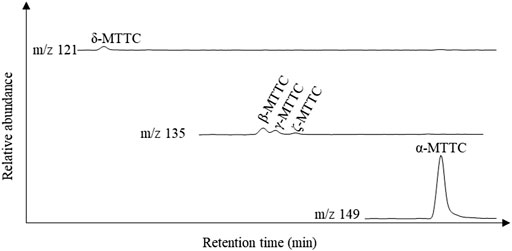
FIGURE 14. Partial m/z 121, 135, and 149 mass chromatograms of a representative sample from well B417, showing the distribution of methyltrimethyltridecylchromans (MTTCs).
5 Conclusion
The results of this study indicated that the crude oil samples from the East Fukang Sag contained 1-ring to 5-ring aromatic hydrocarbons, and were dominated by bicyclic and tricyclic compounds, showing a typical front peak distribution. According to the composition characteristics of the main aromatic hydrocarbons, the crude oil samples could be divided into two types. It was found that Oil type I was characterized by high abundance of naphthalene series, biphenyl series, and dibenzofuran series, while Oil type II was characterized by high abundance of phenanthrene series, fluorene series, triaromatic steroid series, and obvious MTTCs. Based on source-related and depositional environment-related aromatic parameters, two types of crude oil showed distinct geochemical characteristics. Oil type I was derived from a source containing predominantly terrestrial higher plant organic matter deposited in a partially oxidized freshwater environment, while the organic matter of Oil type II was mainly lower aquatic organism and deposited in a relatively reductive and fresh-brackish lacustrine environment.
The selected maturity parameters of alkyl naphthalenes, alkyl phenanthrenes, alkyl dibenzothiophenes and MTTCs are effective in estimating the maturity of the crude oil from the East Fukang Sag. The results revealed that the studied oil samples have entered the mature stage, despite the calculated vitrinite reflectance based on different series of aromatic hydrocarbons were slightly deviated. This was further supported by well-established maturity parameters based on sterane and hopane isomerization ratios from saturated hydrocarbons.
Data availability statement
The original contributions presented in the study are included in the article/Supplementary Material, further inquiries can be directed to the corresponding author.
Author contributions
YL: Investigation, Methodology, Writing—review and editing. DH: Conceptualization, Methodology, Supervision. XC and XH: Investigation, Writing—review. CN: review and English editing.
Funding
The project was supported by the National Natural Science Foundation of China (No. 41872131).
Acknowledgments
The authors would like to thank the CNPC Xinjiang Oilfield Company for providing the oil samples and basic information.
Conflict of interest
The authors declare that the research was conducted in the absence of any commercial or financial relationships that could be construed as a potential conflict of interest.
Publisher’s note
All claims expressed in this article are solely those of the authors and do not necessarily represent those of their affiliated organizations, or those of the publisher, the editors and the reviewers. Any product that may be evaluated in this article, or claim that may be made by its manufacturer, is not guaranteed or endorsed by the publisher.
References
Alexander, R., Cumbers, K. M., and Kagi, R. I. (1986). Alkylbiphenyls in ancient sediments and petroleums. Org. Geochem. 10, 841–845. doi:10.1016/s0146-6380(86)80021-3
Alexander, R., Larcher, A. V., Kagi, R. I., and Price, P. L. (1992). “An oil-source correlation study using age-specific plant-derived aromatic biomarkers,” in Biological markers in sediments and Petroleum. Editors J. M. Moldowan, P. Albrecht, and R. P. Philp (Englewood Cliffs, New Jersey, USA: Prentice-Hall), 201–221.
Alexander, R., Larcher, A. V., Kagi, R. I., and Price, P. L. (1988). The use of plant derived biomarkers for correlation of oils with source rocks in the Cooper/Eromanga Basin System, Australia. APPEA J. 28, 310–324. doi:10.1071/aj87024
Armstroff, A., Wilkes, H., Schwarzbauer, J., Littke, R., and Horsfield, B. (2006). Aromatic hydrocarbon biomarkers in terrestrial organic matter of Devonian to Permian age. Palaeogeogr. Palaeoclimatol. Palaeoecol. 240, 253–274. doi:10.1016/j.palaeo.2006.03.052
Bai, H., Pang, X., Kuang, L., Wan, Z., Pang, H., Wang, X., et al. (2017). Depositional environment, hydrocarbon generation and expulsion potential of the middle Permian Pingdiquan source rocks based on geochemical analyses in the eastern Junggar Basin, NW China. Aust. J. Earth Sci. 64, 497–518. doi:10.1080/08120099.2017.1310139
Bao, J. P., Ni, C. H., Zhu, C. S., Jiang, X. C., and Shen, X. (2020). Triaromatic steroids and their geochemical significance in highly mature geological samples in the north Guizhou Depression. Acta Sedimentol. Sin. 38, 898–911. doi:10.14027/j.issn.1000-0550.2019.069
Bao, J. P., Zhu, C. S., and Ma, A. L. (2009). The relationship between methylated chromans and maturity of organic matter in the source rocks from Jianghan hypersaline basin. Sci. China Ser. D-Earth. Sci. 52, 34–41. doi:10.1007/s11430-009-5018-4
Budzinski, H., Garrigues, P. H., Connan, J., Devillers, J., Domine, D., Radke, M., et al. (1995). Alkylated phenanthrene distributions as maturity and origin indicators in crude oils and rock extracts. Geochim. Cosmochim. Acta 59, 2043–2056. doi:10.1016/0016-7037(95)00125-5
Cao, B., Luo, X., Zhang, L., Sui, F., Lin, H., and Lei, Y. (2017). Diagenetic evolution of deep sandstones and multiple-stage oil entrapment: A case study from the lower jurassic sangonghe formation in the Fukang sag, central Junggar basin (NW China). J. Pet. Sci. Eng. 152, 136–155. doi:10.1016/j.petrol.2017.02.019
Chakhmakhchev, A., Suzuki, M., and Takayama, K. (1997). Distribution of alkylated dibenzothiophenes in petroleum as a tool for maturity assessments. Org. Geochem. 26, 483–489. doi:10.1016/s0146-6380(97)00022-3
Chen, J. P., Wang, X. L., Deng, C. P., Liang, D. G., Zhang, Y. Q., Zhao, Z., et al. (2016). Geochemical features of source rocks and crude oil in the Junggar Basin, Northwest China. Acta Geol. Sin. 90, 37–67. doi:10.3969/j.issn.0001-5717.2016.01.003
Chen, Z., Xie, J., Qiao, R., Qiu, L., Yang, Y., Wen, Z., et al. (2022). Geochemistry and accumulation of jurassic oil in the central Junggar basin, Western China. J. Pet. Sci. Eng. 216, 110855. doi:10.1016/j.petrol.2022.110855
Cheng, B., Liu, H., Cao, Z., Wu, X., and Chen, Z. (2020). Origin of deep oil accumulations in carbonate reservoirs within the north tarim basin: Insights from molecular and isotopic compositions. Org. Geochem. 39, 103931. doi:10.1016/j.orggeochem.2019.103931
Cumbers, K. M., Alexander, R., and Kagi, R. I. (1987). Methylbiphenyl, ethylbiphenyl and dimethylbiphenyl isomer distributions in some sediments and crude oils. Geochim. Cosmochim. Acta 51, 3105–3111. doi:10.1016/0016-7037(87)90121-9
Fan, P., Philp, R. P., Li, Z. X., and Ying, G. G. (1990). Geochemical characteristics of aromatic hydrocarbons of crude oils and source rocks from different sedimentary environments. Org. Geochem. 16, 427–435. doi:10.1016/0146-6380(90)90059-9
Fang, R., Wang, T. G., Li, M., Xiao, Z., Zhang, B., Huang, S., et al. (2016). Dibenzothiophenes and benzo [b] naphthothiophenes: Molecular markers for tracing oil filling pathways in the carbonate reservoir of the Tarim Basin, NW China. Org. Geochem. 91, 68–80. doi:10.1016/j.orggeochem.2015.11.004
Fu, H., Wang, Z. Q., Wang, Z. S., Pang, Q. W., and Kuang, H. (2011). Geochemical characteristics of middle-lower Jurassic coal measures in Fukang sag. Petrol. Geol. Eng. 25, 32–35+59+6. doi:10.3969/j.issn.1673-8217.2011.06.010
Gong, D., Song, Y., Wei, Y., Liu, C., Wu, Y., Zhang, L., et al. (2019). Geochemical characteristics of Carboniferous coaly source rocks and natural gases in the Southeastern Junggar Basin, NW China: Implications for new hydrocarbon explorations. Int. J. Coal Geol. 202, 171–189. doi:10.1016/j.coal.2018.12.006
Guo, X., and He, S. (2009). Aromatic hydrocarbons as indicators of origin and maturation for light oils from Panyu lower uplift in Pearl River Mouth basin. J. Earth Sci. 20, 824–835. doi:10.1007/s12583-009-0063-7
He, D. F., Zhang, L., Wu, S. T., Li, D., and Zhen, Y. (2018). Tectonic evolution stages and features of the Junggar Basin. Oil Gas. Geol. 39, 845–861. doi:10.11743/ogg20180501
Huang, X. Y., Jiao, D., Lu, L. Q., Huang, J. H., and Xie, S. C. (2006). Distribution and geochemical implication of aromatic hydrocarbons across the meishan permian-triassic boundary. J. China Univ. Geosciences 17, 49–54. doi:10.1016/s1002-0705(06)60006-x
Hughes, W. B., Holba, A. G., and Dzou, L. I. P. (1995). The ratios of dibenzothiophene to phenanthrene and pristane to phytane as indicators of depositional environment and lithology of petroleum source rocks. Geochim. Cosmochim. Acta 59, 3581–3598. doi:10.1016/0016-7037(95)00225-o
Jia, C. S., Wang, Y. B., Gu, Y., and Huang, J. W. (2009). Geochemical characteristics of aromatic hydrocarbons of crude oils from Ordovician reservoir in the Tahe Oilfield. Petrol. Geol. Exp. 31, 384–388. doi:10.11781/sysydz200904384
Jiang, K., Lin, C., Li, H., and Chen, Q. (2018). Effect of paleosalinity and maturity on the distribution of dimethyl-MTTCs. Pet. Sci. Technol. 36, 2037–2042. doi:10.1080/10916466.2018.1531027
Justwan, H., Dahl, B., and Isaksen, G. H. (2006). Geochemical characterisation and genetic origin of oils and condensates in the South Viking Graben, Norway. Mar. Pet. Geol. 23, 213–239. doi:10.1016/j.marpetgeo.2005.07.003
Koopmans, M. P., Rijpstra, W. I. C., de Leeuw, J. W., Lewan, M. D., and Sinninghe Damsté, J. S. (1998). Artificial maturation of an immature sulfur- and organic matter-rich limestone from the Ghareb Formation, Jordan. Org. Geochem. 28, 503–521. doi:10.1016/s0146-6380(98)00015-1
Kvalheim, O. M., Christy, A. A., Telnæs, N., and Bjørseth, A. (1987). Maturity determination of organic matter in coals using the methylphenanthrene distribution. Geochim. Cosmochim. Acta 51, 1883–1888. doi:10.1016/0016-7037(87)90179-7
Li, M. J., Wang, Y., Wang, T., and Ren, P. (2003). The characteristics of carbon isotope composition of the Dongbu depression in the Liaohe Basin. Geoscience 17, 217–221. doi:10.3969/j.issn.1000-8527.2003.02.016
Li, M., Wang, T. G., Lillis, P. G., Wang, C., and Shi, S. (2012). The significance of 24-norcholestanes, triaromatic steroids and dinosteroids in oils and Cambrian–Ordovician source rocks from the cratonic region of the Tarim Basin, NW China. Appl. Geochem. 27, 1643–1654. doi:10.1016/j.apgeochem.2012.03.006
Li, M., Wang, T., Yang, F., and Shi, Y. (2011). Molecular tracer markers for filling pathway in condensate reservoirs: Alkyldibenzofurans. J. Oil Gas. Technol. 33, 6–11. doi:10.3969/j.issn.1000-9752.2011.03.002
Li, S. F., and He, S. (2008). Geochemical characteristics of dibenzothiophene, dibenzofuran and fluorene and their homologues and their environmental indication. Geochimica 37, 45–50. doi:10.3321/j.issn:0379-1726.2008.01.006
Li, Y., Zhu, Y. M., Hao, F., Zou, H. Y., and Guo, T. L. (2015). Thermal evolution and applications of aromatic hydrocarbons in highly mature coal-bearing source rocks of the Upper Triassic Xujiahe Formation in the northern Sichuan Basin. Sci. China Earth Sci. 58, 1960–1969. doi:10.1007/s11430-015-5084-8
Liu, H., Li, H., Xiang, H., Wang, X., and Du, S. (2020). Geochemistry, Genesis and distribution of crude oils in the Fukang fault zones and their periphery in Junggar Basin. Nat. Gas. Geosci. 31, 258–267. doi:10.11764/j.issn.1672-1926.2019.09.007
Luo, J., Cheng, K. M., Fu, L. X., Hu, Y. J., and Jiang, N. H. (2001). Alkylated dibenzothiophene index—a new method to assess thermal maturity of source rocks. Acta Pet. Sin. 22, 27–31. doi:10.7623/syxb200103006
Luo, L., Gao, X., Tan, X., Gluyas, J., Wang, J., Kong, X., et al. (2019). Paleo-environment and provenance in a lacustrine shallow-water delta-meandering river sedimentary system: Insights from the middle–upper jurassic formations of the Fukang sag of Junggar basin, NW China. Aust. J. Earth Sci. 66, 699–722. doi:10.1080/08120099.2018.1564695
Ma, C., Wu, K., Pei, Y., and Li, T. (2019a). Quantitative analysis of tectonic characteristics and evolution in the eastern Junggar Basin. J. Geomech. 25, 313–323. doi:10.12090/j.issn.1006-6616.2019.25.03.029
Ma, S., Luo, J., He, X., Xu, X., and Dai, J. (2019b). The influence of fracture development on quality and distribution of volcanic reservoirs: A case study from the carboniferous volcanic reservoirs in the xiquan area, eastern Junggar basin. Arab. J. Geosci. 12, 110–115. doi:10.1007/s12517-019-4228-0
Meng, J. H., Liu, L. F., Zhang, M., and Wang, Y. (2011). Indicative function of aromatic hydrocarbon in crude oil on depositional environment. J. China Univ. Min. Technol. 40, 901–907.
Pan, H., Lin, X., Gong, L., Qiao, C., and Xu, H. (2015). Geochemistry of oil and identification of source rocks in the Dinan arch-Fubei slope area of Junggar Basin. Mar. Geol. Quat. Geol. 35, 155–161. doi:10.16562/j.cnki.0256-1492.2015.04.017
Peters, K. E., and Moldowan, J. M. (1993). The biomarker guide: Interpreting molecular fossils in Petroleum and ancient sediments. Englewood Cliffs, New Jersey, USA: Prentice-Hall.
Peters, K. E., Walters, C. C., and Moldowan, J. M. (2005). The biomarker guide. 2nd ed. New York: Cambridge University Press.
Philp, R. P., and Gilbert, T. D. (1986). Biomarker distributions in Australian oils predominantly derived from terrigenous source material. Org. Geochem. 10, 73–84. doi:10.1016/0146-6380(86)90010-0
Püttmann, W., and Villar, H. (1987). Occurrence and geochemical significance of 1, 2, 5, 6-tetramethylnaphthalene. Geochim. Cosmochim. Acta 51, 3023–3029. doi:10.1016/0016-7037(87)90375-9
Qiao, J., Liu, L., and Shang, X. (2020). Deposition conditions of the jurassic lacustrine source rocks in the east Fukang sag, Junggar basin, NW China: Evidence from major and trace elements. Geol. J. 55, 4936–4953. doi:10.1002/gj.3714
Radke, M. (1988). Application of aromatic compounds as maturity indicators in source rocks and crude oils. Mar. Pet. Geol. 5, 224–236. doi:10.1016/0264-8172(88)90003-7
Radke, M., Rullkötter, J., and Vriend, S. P. (1994). Distribution of naphthalenes in crude oils from the Java Sea: Source and maturation effects. Geochim. Cosmochim. Acta 58, 3675–3689. doi:10.1016/0016-7037(94)90158-9
Radke, M., Welte, D. H., and Willsch, H. (1982). Geochemical study on a well in the western Canada basin: Relation of the aromatic distribution pattern to maturity of organic matter. Geochim. Cosmochim. Acta 46, 1–10. doi:10.1016/0016-7037(82)90285-x
Radke, M., Welte, D. H., and Willsch, H. (1986). Maturity parameters based on aromatic hydrocarbons: Influence of the organic matter type. Org. Geochem. 10, 51–63. doi:10.1016/0146-6380(86)90008-2
Radke, M., and Willsch, H. (1994). Extractable alkyldibenzothiophenes in Posidonia shale (Toarcian) source rocks: Relationship of yields to petroleum formation and expulsion. Geochim. Cosmochim. Acta 58, 5223–5244. doi:10.1016/0016-7037(94)90307-7
Schoell, M. (1984). Recent advances in petroleum isotope geochemistry. Org. Geochem. 6, 645–663. doi:10.1016/0146-6380(84)90086-x
Schwark, L., and Püttmann, W. (1990). Aromatic hydrocarbon composition of the permian kupferschiefer in the lower rhine basin, NW Germany. Org. Geochem. 16, 749–761. doi:10.1016/0146-6380(90)90114-f
Shi, H. (2017). Jurassic reservoir development in Fukang deep sag, central Junggar basin. Petrol. Geol. Exp. 39, 238–246. doi:10.11781/sysydz201702238
Shi, J., Zhou, Y. R., Yu, J., and Liu, J. J. (2018). Paleoenvironment of organic-rich shale from the Lucaogou Formation in the Fukang sag, Junggar basin, China. Nat. Gas. Geosci. 29, 1138–1150. doi:10.11764/j.issn.1672-1926.2018.06.016
Singh, R. K., Alexander, R., and Kagi, R. I. (1994). Identification and occurrence of norcadalenes and related compounds in crude oils and sediments. Org. Geochem. 21, 249–256. doi:10.1016/0146-6380(94)90188-0
Sinninghe Damsté, J. S., Kock-Van Dalen, A. C., De Leeuw, J. W., Schenck, P. A., Sheng, G., and Brassell, S. C. (1987). The identification of mono-di- and trimethyl 2-methyl-2-(4, 8, 12-trimethyltridecyl)chromans and their occurrence in the geosphere. Geochim. Cosmochim. Acta 51, 2393–2400. doi:10.1016/0016-7037(87)90292-4
Song, Y., Wang, X., Guo, X., Liu, C., Li, H., and Liu, D. (2020). Analysis on causes of differences in physical properties of Jurassic crude oil around Fukang depression, Junggar Basin. Pet. Sci. Technol. 38, 75–82. doi:10.1080/10916466.2019.1664571
Stojanović, K., Jovančićević, B., Vitorovi, D., Golovko, J., Pevneva, G., and Golovko, A. (2007a). Hierarchy of maturation parameters in oil-source rock correlations. case study: Drmno depression, Southeastern Pannonian Basin, Serbia and Montenegro. J. Pet. Sci. Eng. 55, 237–251. doi:10.1016/j.petrol.2006.07.009
Stojanović, K., Jovančićević, B., Vitorovi, D., Pevneva, G. S., Golovko, J. A., and Golovko, A. K. (2007b). New maturation parameters based on naphthalene and phenanthrene isomerization and dealkylation processes aimed at improved classification of crude oils (Southeastern Pannonian Basin, Serbia). Geochem. Int. 45, 781–797. doi:10.1134/s0016702907080058
Strachan, M. G., Alexander, R., and Kagi, R. I. (1988). Trimethylnaphthalenes in crude oils and sediments: Effects of source and maturity. Geochim. Cosmochim. Acta 52, 1255–1264. doi:10.1016/0016-7037(88)90279-7
Tuo, J. C. (1996). Geochemistry of the tertiary aromatic hydrocarbons in the Qaidam Basin-relationship between dicyclic and polycyclic aromatic hydrocarbons. Petrol. Geol. Exp. 18, 406–412. doi:10.11781/sysydz199604406
van Aarssen, B. G., Alexander, R., and Kagi, R. I. (2000). Higher plant biomarkers reflect palaeovegetation changes during Jurassic times. Geochim. Cosmochim. Acta 64, 1417–1424. doi:10.1016/s0016-7037(99)00432-9
Volkman, J. K., Alexander, R., Kagi, R. I., Rowland, S. J., and Sheppard, P. N. (1984). Biodegradation of aromatic hydrocarbons in crude oils from the Barrow Sub-basin of Western Australia. Org. Geochem. 6, 619–632. doi:10.1016/0146-6380(84)90084-6
Wan, Z., Shi, Q., Zhang, Q., Cai, S., and Xia, B. (2015). Characteristics and developmental mechanisms of mud volcanoes on the southern margin of the Junggar Basin, NW China. Geol. J. 50, 434–445. doi:10.1002/gj.2547
Wang, L., Chen, S., Zhang, H., Zou, X., Zhan, P., and Lu, J. (2016). Geochemical characteristic and origin of solid bitumen in the jurassic and triassic sandstone reservoir of santai area, Junggar basin, NW China. Pet. Sci. Technol. 34, 539–545. doi:10.1080/10916466.2016.1153656
Wang, Y., Lin, M., Xi, K., Cao, Y., Wang, J., Yuan, G., et al. (2018). Characteristics and origin of the major authigenic minerals and their impacts on reservoir quality in the Permian Wutonggou Formation of Fukang Sag, Junggar Basin, Western China. Mar. Pet. Geol. 97, 241–259. doi:10.1016/j.marpetgeo.2018.07.008
Waples, D. W., and Machihara, T. (1990). Application of sterane and triterpane biomarkers in petroleum exploration. B. Can. Petrol. Geol. 38, 357–380. doi:10.35767/gscpgbull.38.3.357
Wei, Z., Zhang, D., Zhang, C., and Chen, J. (2001). Methyldibenzothiophenes distribution index as a tool for maturity assessments of source rocks. Geochimica 30, 242–247. doi:10.19700/j.0379-1726.2001.03.007
Wu, J., You, L., and Yang, H. (2013). Structural evolution and hydrocarbon accumulation of Fukang fault zone in Junggar Basin. Xinjiang Petrol. Geol. 34, 36–40. doi:10.3969/j.issn.1001-3873.2013.01.011
Wu, K., Zha, M., Wang, X., Qu, J., and Chen, X. (2005). Further researches on the tectonic evolution and dynamic setting of the Junggar Basin. Acta Geosci. Sin. 26, 217–222. doi:10.3321/j.issn:1006-3021.2005.03.004
Xu, H., George, S. C., and Hou, D. (2019). Algal-derived polycyclic aromatic hydrocarbons in Paleogene lacustrine sediments from the dongying depression, bohai bay basin, China. Mar. Pet. Geol. 102, 402–425. doi:10.1016/j.marpetgeo.2019.01.004
Yang, B., Liao, J. D., Han, J., Qin, J., Ren, J. L., and Kang, S. F. (2005). Geochemical characteristics of crude oil in santai area, Junggar basin. Xinjiang Petrol. Geol. 26, 35–40. doi:10.3969/j.issn.1001-3873.2005.05.006
Yang, F., Song, Y., Chen, H., Gong, D., Bian, B., and Liu, H. (2019). Evalution of carboniferous songkaersu formation source rocks and gas-source correlation in the Fukang sag of eastern Junggar basin. Nat. Gas. Geosci. 30, 1018–1026. doi:10.11764/j.issn.1672-1926.2019.03.006
Yang, H., Wang, H., and Liao, J. (2012). Geochemical characteristics and classification of crude oils in the uplift belt of the surrounding Fukang Sag in the eastern Junggar Basin. J. Yangtze Univ. Nat. Sci. Edit.) 9, 32–35. doi:10.3969/j.issn.1673-1409(N).2012.08.011
Zhang, X., Yang, T., Yue, H., Wu, J., and Di, W. (2020). Hydrocarbon potential evaluation of Triassic source rock of Fukang Sag. Xinjiang Oil Gas. 16, 17–20+ 1–2. doi:10.3969/j.issn.1673-2677.2020.03.005
Zhu, Y. M. (1996). Geochemical characteristics of aromatic hydrocarbon from oils in the Tarim Basin. Geochimica 25, 10. doi:10.19700/j.0379-1726.1996.01.002
Keywords: aromatic hydrocarbons, sedimentary environment, thermal maturity, Fukang Sag, source of organic matter
Citation: Li Y, Hou D, Cheng X, Han X and Niu C (2023) Geochemical characteristics and significance of aromatic hydrocarbons in crude oil from the East Fukang Sag, Junggar Basin, NW China. Front. Earth Sci. 10:1031367. doi: 10.3389/feart.2022.1031367
Received: 29 August 2022; Accepted: 31 October 2022;
Published: 17 January 2023.
Edited by:
Amr Deaf, Assiut University, EgyptReviewed by:
Mohamed M. El Nady, Egyptian Petroleum Research Institute, EgyptDouaa Fathy, Minia University, Egypt
Copyright © 2023 Li, Hou, Cheng, Han and Niu. This is an open-access article distributed under the terms of the Creative Commons Attribution License (CC BY). The use, distribution or reproduction in other forums is permitted, provided the original author(s) and the copyright owner(s) are credited and that the original publication in this journal is cited, in accordance with accepted academic practice. No use, distribution or reproduction is permitted which does not comply with these terms.
*Correspondence: Dujie Hou, aG91ZGozMTNAMTYzLmNvbQ==
 Yan Li
Yan Li Dujie Hou
Dujie Hou Xiong Cheng1,2
Xiong Cheng1,2